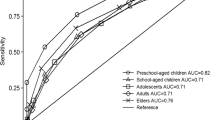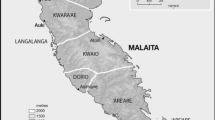Abstract
Objective: This study assesses whether a simple count of food items and food groups can predict the nutritional adequacy of the diet in an economically poor country.
Design: A three-day weighed record of children.
Setting: Koutiala town, in Southeastern Mali.
Subjects: Seventy-seven children, 13–58 months of age. One child was excluded owing to an extraordinarily low food variety.
Intervention: The study was conducted in April–August 1995. Data from this study were used to create two different indices: Food Variety Score (FVS), a simple count of food items, and Dietary Diversity Score (DDS), a count of food groups. Mean Adequacy Ratio (MAR) was calculated as an indicator for nutrient adequacy, and used to validate FVS and DDS.
Results: Mean (s.d.) FVS was 20.5 (3.8) and mean (s.d.) DDS was 5.8 (1.1). A positive correlation was found both between FVS and MAR (Pearson 0.33, P<0.001) and DDS and MAR (Pearson 0.39, P<0.001). With cut-off points for FVS at 23 and for DDS at 6, the indices have high ability to identify those with a nutritionally inadequate diet. MAR increased with increasing FVS and DDS. FVS needs to be at least 15 or DDS at least 5 to give a satisfactory MAR.
Conclusion: Although a simple count of food items or food groups cannot give a full picture of the adequacy of the nutrient intake, the results from this study show that the food scores can give a fairly good assessment of the nutritional adequacy of the diet, particularly if combined. Such indicators are important for identification of vulnerable groups in areas where people normally eat from a shared bowl, which makes detailed dietary intake studies difficult, time consuming and expensive.
Sponsorship: The Norwegian Universities’ Committee for Development Research (NUFU), the Norwegian Research Council and the Nordic Africa Institute funded the project.
This is a preview of subscription content, access via your institution
Access options
Subscribe to this journal
Receive 12 print issues and online access
$259.00 per year
only $21.58 per issue
Buy this article
- Purchase on Springer Link
- Instant access to full article PDF
Prices may be subject to local taxes which are calculated during checkout
Similar content being viewed by others
Author information
Authors and Affiliations
Rights and permissions
About this article
Cite this article
Hatløy, A., Torheim, L. & Oshaug, A. Food variety—a good indicator of nutritional adequacy of the diet? A case study from an urban area in Mali, West Africa. Eur J Clin Nutr 52, 891–898 (1998). https://doi.org/10.1038/sj.ejcn.1600662
Received:
Revised:
Accepted:
Published:
Issue Date:
DOI: https://doi.org/10.1038/sj.ejcn.1600662
Keywords
This article is cited by
-
Association between dietary diversity, sedentary time outside of work and depressive symptoms among knowledge workers: a multi-center cross-sectional study
BMC Public Health (2024)
-
Diet diversity and food quality score in male football players and healthy non-athlete controls in relation to oxidative stress biomarkers: a descriptive-analytical study
BMC Sports Science, Medicine and Rehabilitation (2023)
-
The relationship between diet quality indices and odds of breast cancer in women: a case–control study
BMC Women's Health (2023)
-
Dietary diversity and micronutrients adequacy among the women of reproductive age at St. Martin’s island in Bangladesh
BMC Nutrition (2023)
-
Trends in energy and macronutrient intake among Taiwanese older adults in 1999–2000, 2005–2008 and 2013–2016 periods
BMC Public Health (2023)



